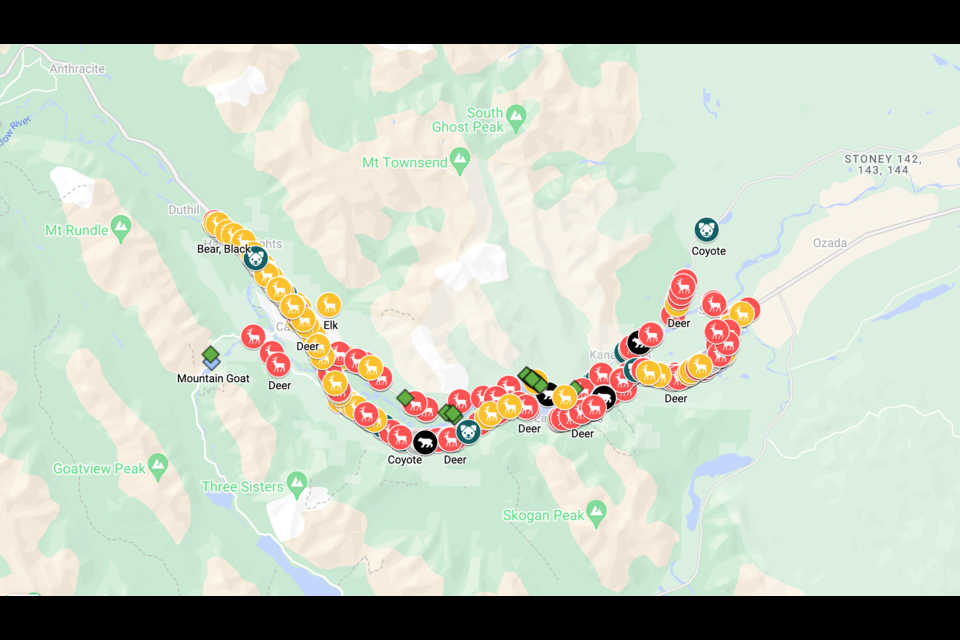CANMORE – One of the Bow Valley's majestic bull elks was struck and killed on the Trans-Canada Highway earlier this week, renewing calls for a reduced speed limit while awaiting construction of a wildlife exclusion fence scheduled to break ground in 2025.
Police say a semi-trailer struck and killed one elk around 8:20 p.m. on Sunday (Sept. 15) between the two eastern exits to Canmore, which temporarily shut down the highway as several cow elk had also made their way onto the unfenced highway and were running around.
“One elk was hit by a semi,” said RCMP Cpl. Gina Slaney. “No injuries or damage.”
The large bulls around town are engaging in a series of dramatic behaviours as they round up female elk into harems and assert dominance over other rival males as part of the dramatic fall rut.
Gauging each other’s fitness and ability to defend the right to breed, the bulls will wage violent battles with other bulls for a harem, with their eerie bugling signalling to potential mates and also warning other males to keep their distance.
Coun. Wade Graham, who was one of the driving forces behind Canmore council’s lobbying efforts to the province for highway mitigations near Canmore, said he was devastated to hear the news.
“We’re in the peak of the rut right now and they’re doing their thing right now and there’s a highway that’s getting in the way of that,” he said.
“To be taken out by a vehicle is more than a shame. Bulls getting removed like that is totally preventable and that’s the part that’s disappointing to me.”
Canmore resident Ewan Clark, who was stuck in traffic on the highway for about 15 minutes as police and fire personnel dealt with the situation on Sunday, spotted a dead bull in the median once traffic flow resumed.
“He was a pretty big bull… the size of the biggest one I had seen around,” he said.
Clark said he has seen multiple elk carcasses along that stretch of road, including at least four or five female elk in recent times, but to see such a large majestic male elk lying dead in the ditch “was incredibly impactful to me.”
“Seeing the impact of traffic, development and habitat loss on them in such an obvious way is a real shame,” he said.
“It’s a common occurrence to see them hit by traffic. Something needs to be done for sure.”
Provincial government officials say construction of a10-kilometre wildlife exclusion fence along the Trans-Canada Highway near Canmore is expected to reduce wildlife-vehicle collisions by as much as 80 per cent.
Alexandru Cioban, press secretary for Transportation and Economic Corridors Minister Devin Dreeshen, said construction on the fence, which will extend from the Bow River to the east gate of Banff National Park, is set to begin in 2025.
“This initiative is part of our government’s broader plan to expand wildlife mitigation efforts, ultimately increasing the total length of fencing along highways 1, 1A, and 1X in the Bow Valley to 146 kilometres,” he said.
But, until the fence is built, Graham and other members of the community are calling for a reduced speed limit on the stretch of highway near Canmore, from 100-km/h to 90-km/h to align with neighbouring Banff National Park.
“That makes sense to me and I think that should happen sooner than later,” Graham said.
“This isn’t just about animals. It’s also about people and property. Insurance claims and property damage is significant.”
Highways are barriers for wide-ranging mammals such as grizzly bears, black bears, wolves, cougars, deer and elk. These animals and others need to move through the landscape to access food, water, safety and mates.
Not only is the Bow Valley one of the most important regional wildlife corridors in Alberta and the broader Yellowstone to Yukon region, but is also a busy thoroughfare for people with a staggering 34,000 vehicles buzzing through on the highway every day throughout summer.
In neighbouring Banff National Park, wildlife exclusion fencing that parallels the highway throughout the park has reduced wildlife-vehicle collisions by more than 80 per cent and, for elk and deer alone, by more than 96 per cent.
In addition to the fencing, there are 38 wildlife underpasses and six overpasses along an 82-kilometre stretch of highway from the national park’s east entrance to the border of Yoho National Park, British Columbia.
Cioban said the province’s construction of the first wildlife overpass on the Trans-Canada Highway outside of Banff National Park east of Lac Des Arcs continues.
“This project is anticipated to be completed by the end of October,” he said.




